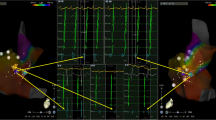Abstract
The onset of recurrent or sustained atrial fibrillation (AF) is common during electrophysiological (EP) studies of accessory pathways (AP). We report our experience in patients with Wolff-Parkinson-White (WPW) syndrome in whom AF with rapid antegrade conduction over the AP occurred during an EP study and mapping and ablation were done during sustained AF, as compared to patients ablated during sinus rhythm. The study group consisted of 18 patients (group 1) with WPW syndrome who underwent catheter ablation during pre-excited AF. Two hundred and sixty-three patients, comparable for clinical characteristics, whose manifest APs were ablated under sinus rhythm formed the control group (group 2). Bipolar electrogram criteria recorded from the ablation catheter showing early ventricular activation relative to the delta wave on the surface ECG and AP potentials preceding the onset of ventricular activation were used as targets for ablation. Clinically documented atrial fibrillation was significantly more frequent and antegrade ERP of AP was significantly shorter in group 1 than in group 2 (39% vs 14%, P = 0.014 and 268 ± 37 vs 283 ± 16, P < 0.001, respectively). Procedure-related variables, acute success rates (17/18 [94%] in group 1, 251/263 [95%] in group 2; P > 0.05) and late recurrence rates (0/18 [0%] in group 1 vs 5/263 [2%] in group 2; P > 0.05) during a mean follow-up of 25 ± 9 months (range 8–52 months) did not differ significantly. Our results show that both right- and left-sided accessory pathways can be mapped and ablated safely during pre-excited AF without delay, and that acute success and recurrence rates and long-term follow-up results are similar to those of pathways ablated during sinus rhythm.
Similar content being viewed by others
References
WM Jackman XZ Wang KJ Friday CA Roman KP Moulton KJ Beckman JH McClelland N Twidale HA Hazlitt MI Prior (1991) ArticleTitleCatheter ablation of accessory atrioventricular pathways (Wolff-Parkinson-White syndrome) by radiofrequency current N Engl J Med 324 1605–1611
M Schluter M Geiger J Siebels W Duckeck KH Kuck (1991) ArticleTitleCatheter ablation using radiofrequency current to cure symptomatic patients with tachyarrhythmias related to accessory atrioventricular pathway Circulation 84 1644–1661
H Calkins J Langberg J Sousa R el-Atassi A Leon W Kou S Kalbfleisch F Morady (1992) ArticleTitleRadiofrequency catheter ablation of accessory atrioventricular connections in 250 patients. Abbreviated therapeutic approach to Wolf-Parkinson-White syndrome Circulation 85 1337–1346
MD Lesh GF Van Hare DJ Schamp W Chien MA Lee JC Griffin JJ Langberg TJ Cohen KG Lurie MM Scheinman (1992) ArticleTitleCurative percutaneous catheter ablation using radiofrequency energy for accessory pathways in all locations: results in 100 consecutive patients J Am Coll Cardiol 19 1303–1309
H Calkins J Sousa R el-Atassi S Rosenheck M de Buitleir WH Kou AH Kadish JJ Langberg F Morady (1991) ArticleTitleDiagnosis and cure of the Wolff-Parkinson-White-syndrome or paroxysmal supraventricular tachycardias during a single electrophysiologic test N Engl J Med 23 1612–1618
X Chen M Borggrefe M Shenasa W Haverkamp G Hindricks G Breithardt (1992) ArticleTitleCharacteristics of local electrogram predicting successful transcatheter radiofrequency ablation of left-sided accessory pathways J Am Coll Cardiol 20 656–665
S Kose A Iyisoy H Kursaklioglu (2003) ArticleTitleRadiofrequency catheter ablation of an accessory pathway during preexcited atrial fibrillation Acta Cardiol 58 159–162
G Hindricks H Kottkamp X Chen S Willems G Breithardt M Borggrefe (1995) ArticleTitleSuccessful radiofrequency ablation of right sided accessory pathways during sustained atrial fibrillation Eur Heart J 16 967–970
G Hindricks H Kottkamp X Chen S Willems W Haverkamp M Shenasa G Breithardt M Borggrefe (1995) ArticleTitleLocalization and radiofrequency catheter ablation of left-sided accessory pathways during atrial fibrillation. Feasibility and electrogram criteria for identification of appropriate target sites J Am Coll Cardiol 25 444–451
PI Iturraide Torres S Kershenovich L Colin Lizalde F Cruz Cruz H Rodriguez Reyes A de Micheli JA Gonzalez Hermosillo (1997) ArticleTitleRadiofrequency ablation of accessory pathways in the presence of atrial fibrillation Arch Inst Cardiol Mex 67 475–479
J Siller Rodriguez F de la Fuente F Cedillo Salazar I Flores-Delgado (1998) ArticleTitleThe radiofrequency ablation of a left lateral accessory pathway during pre-excitation atrial fibrillation Arch Inst Cardiol Mex 68 113–118
Author information
Authors and Affiliations
Corresponding author
Rights and permissions
About this article
Cite this article
Kose, S., Amasyali, B., Aytemir, K. et al. Radiofrequency catheter ablation of accessory pathways during pre-excited atrial fibrillation: acute success rate and long-term clinical follow-up results as compared to those patients undergoing successful catheter ablation during sinus rhythm. Heart Vessels 20, 142–146 (2005). https://doi.org/10.1007/s00380-005-0819-7
Received:
Accepted:
Issue Date:
DOI: https://doi.org/10.1007/s00380-005-0819-7




